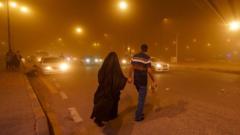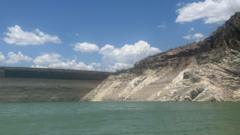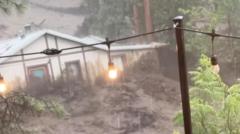A significant sandstorm has swept through central and southern Iraq, leaving over a thousand people suffering from breathing difficulties, with many seeking medical treatment across various provinces. Reports indicate that at least 700 cases of suffocation were documented in Muthanna province alone. Locals captured dramatic footage of the region engulfed in an orange haze, prompting airport closures and disruptions to essential services. Experts link the increasing frequency of such dust storms to climate change, thereby raising concerns about Iraq's environmental future.
Iraq Faces Respiratory Crisis Amid Severe Sandstorm

Iraq Faces Respiratory Crisis Amid Severe Sandstorm
A recent sandstorm in Iraq has severely affected residents' health, leading to widespread respiratory issues.
The extreme weather conditions have triggered a health crisis as more than a thousand individuals reported respiratory complications. Local health officials, reporting for AFP, indicated that Muthanna province accounted for at least 700 cases of suffocation. Eyewitness accounts have described the stark image of communities cloaked in thick orange dust, as the storm significantly reduced visibility to under one kilometer (approximately 0.62 miles). In addition to Muthanna, the impact was felt in other provinces; Najaf saw over 250 people hospitalized, while Diwaniyah reported more than 300 patients requiring medical attention, including children.
This alarming trend observes a continuation of Iraq's struggles with dust storms, which, according to the environment ministry, are expected to increase due to climate change impacts. In response to the sandstorm’s severity, local authorities implemented emergency measures, including airport shutdowns in both Najaf and Basra. As the situation develops, weather agencies predict an improvement in conditions by Tuesday morning, but the long-term outlook remains concerning for Iraq's climate resilience and public health.
In previous incidents, such as a severe sandstorm in 2022, over 5,000 people required treatment for respiratory ailments, highlighting an ongoing public health dilemma exacerbated by environmental changes. As Iraq's environment ministry warns of more "dust days" ahead, the urgent need for preventive measures and public awareness on respiratory health continues to grow.
This alarming trend observes a continuation of Iraq's struggles with dust storms, which, according to the environment ministry, are expected to increase due to climate change impacts. In response to the sandstorm’s severity, local authorities implemented emergency measures, including airport shutdowns in both Najaf and Basra. As the situation develops, weather agencies predict an improvement in conditions by Tuesday morning, but the long-term outlook remains concerning for Iraq's climate resilience and public health.
In previous incidents, such as a severe sandstorm in 2022, over 5,000 people required treatment for respiratory ailments, highlighting an ongoing public health dilemma exacerbated by environmental changes. As Iraq's environment ministry warns of more "dust days" ahead, the urgent need for preventive measures and public awareness on respiratory health continues to grow.





















